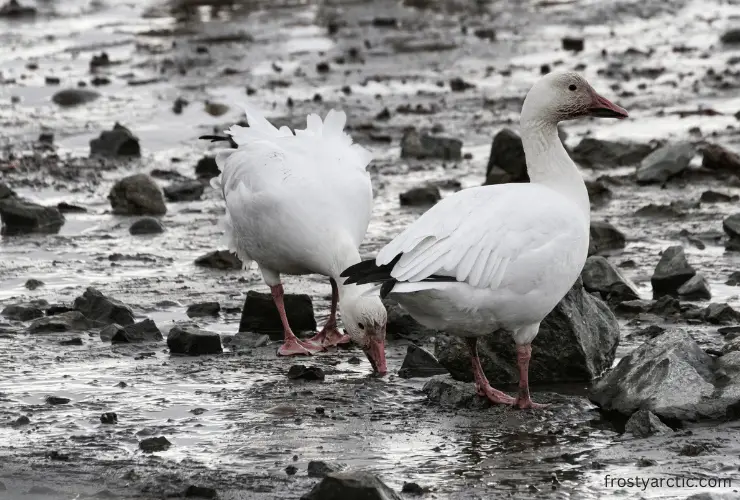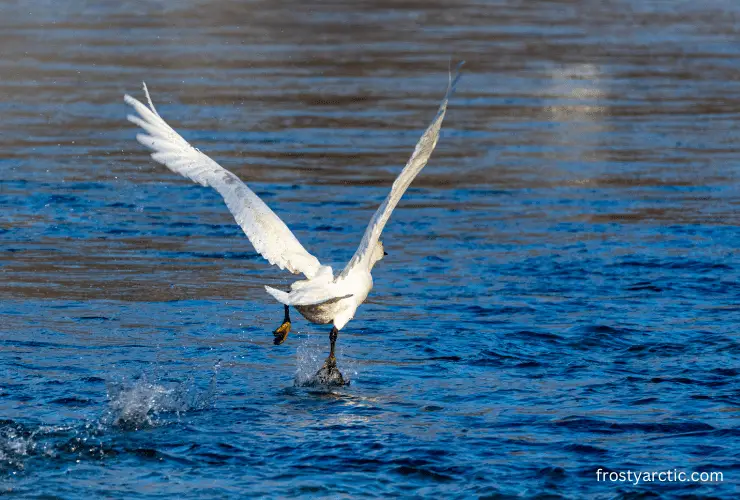Snow geese primarily eat a variety of grasses and grains, including corn, wheat, rye, and barley. They also love to eat tubers, sedges, and other aquatic plants. Besides, they also consume a variety of marine invertebrates, such as mollusks, crustaceans, aquatic insects, small fish, and other small aquatic creatures.
Therefore, studying snow goose diets is crucial to understanding their ecological role and environmental challenges. In fact, like all birds, snow geese need a nutritious diet to survive in their natural environment.
This blog post will examine this magnificent bird’s diet and the foods it consumes. By the end of this article, you will have an in-depth grasp of the dietary habits of snow geese and their impact on Arctic ecosystems.
So, read on to discover more about these beautiful birds!
Is A Snow Goose A Carnivore?
No! The snow goose is not considered a carnivore.
Why aren’t they carnivores?
Snow geese are not carnivores because their digestive systems are not well-suited for processing meat. Moreover, carnivores are animals that feed primarily on the flesh of other animals.

They typically eat the flesh of mammals such as rodents, deer, and antelope, as well as other animals such as fish, birds, reptiles, and amphibians.
On the contrary, snow geese primarily feed on grasses, sedges, and other vegetation. They also eat grains, berries, and other plant materials. Even the structure of their beaks and digestive systems is adapted for grinding and breaking down plant material.
Their beaks are flat and broad, which allows them to slice through tough stems and blades of grass. Their digestive system is also equipped with a large stomach, and a muscular gizzard grinds food into small pieces for digestion.
Besides that, carnivores have sharp, pointed teeth for tearing flesh. Even a short digestive tract allows them to digest meat quickly before it is putrefied. Their digestive systems are not well-suited for processing plant material, so they cannot survive on a herbivorous diet.
Snow geese have evolved to thrive on another diet, and their digestive systems are not adapted for carnivorous diets.
Is A Snow Goose an Herbivore or an Omnivore?
Yes! A snow goose is a species of bird that falls into the herbivore/omnivore category. They can inhabit various habitats, from coastal wetlands to inland grasslands.
Why are they herbivores?
Well, snow geese are primarily herbivores, mainly consuming plant-based foods (we talked about above). However, they occasionally consume fish and insects, making them technically omnivorous rather than purely herbivorous.

Snow geese mainly feed on roots, stems, and seeds. Besides, they also feed on leaves, buds, and fruits. They are known to eat crops such as corn, wheat, and soybeans, which can sometimes bring them into conflict with farmers.
In addition to their primarily herbivorous diet, snow geese consume small invertebrates such as snails and crustaceans. However, animal matter makes up a tiny proportion of their diet, estimated to be less than 1%.
A Table of Charts: Snow Geese’s Primary Food Sources
The snow goose is a versatile bird that can adapt to various environments (from the coast to inland regions). The table below lists some of the snow goose’s primary food sources.
| Food Source | Description |
| Algae | Green or brown aquatic plants |
| Grasses | Herbaceous plants with long, narrow leaves |
| Sedges | Grass-like plants found in wet areas |
| Insects | Small, six-legged arthropods |
| Crustaceans | Shelled invertebrates such as shrimp and crabs |
| Grains | Seeds from grasses and other plants |
| Wild rice | Grass-like aquatic plant |
| Berries | Small, pulpy fruits |
| Aquatic plants | Plants that grow in or near water |
| Crops | Crops grown for human consumption |
Snow Goose Diet – Depending on Season And Location
The snow goose’s diet changes a lot with the seasons and the different places it lives.
Let’s have a look at this chart- (source)
| Season | Location | Food Sources |
| Summer | Northern Breeding Grounds | Herbaceous plants such as algae, grasses, and sedges |
| Winter | Southern Wintering Grounds | Insects, crustaceans, grains, and crops |
Snow Goose Foraging Methods – How Do Snow Goose Eat?
Digging
Snow geese use their feet to dig up roots and other plant parts from the ground. This is a common foraging method in coastal marshes, where snow geese can find tubers, rhizomes, and other below-ground plant parts.
Grazing
Snow geese graze on aboveground vegetation, such as grasses, sedges, and aquatic plants. They use their bills to bite off or shear off the tops of plants.
Picking
Snow geese pick individual plants or plant parts from the ground. This is a common foraging method in agricultural areas, where snow geese can find waste grain and other edible plant parts.
Filter-feeding
Snow geese filter-feed in shallow water. They use their bills to strain small organisms, such as insects and crustaceans, from the water. ~ Source
What Do Snow Geese Eat in The Tundra?
In the tundra, where they live, snow geese eat mostly grasses, sedges, and other plants. They also eat berries, seeds, and roots. However, snow geese feed on a wide range of plant species, including-
- Arctic Willow
- Cotton grass
- Sedges
- Horsetails
- Dwarf Birch
- Crowberry
- Labrador Tea
Snow geese also eat agricultural crops, like wheat, corn, and barley, during their winter migration. Some areas have attempted to manage snow goose populations after conflicts with farmers.
Canada Snow Goose Diet: What Do Canadian Snow Geese Eat?
Canada snow geese are referred to as the greater snow goose species that breeds in Canada, especially in the northern zone.

They primarily eat vegetable matter, such as grass and aquatic vegetation. Aside from that, they also eat rhizomes. In fact, grass is their favorite food and is available throughout the year.
They also have a good way to digest food, with a gizzard. It works better than those chickens and ducks. They don’t directly search for mollusks and crustaceans to eat. But they sometimes consume them near vegetation they consume.
Canada snow geese eat various foods based on whether they are on land or in the water. Following are some key food sources for Canada snow geese.
- Alfalfa
- Bentgrass
- Bermudagrass
- Battails
- Bluegrass
- Corn
- Duckweed
- Eelgrass
- Earthworms
- Freshwater snails
- Grains
- Grasshoppers
- Root bulbs
- Shrimp
- Sedge
- Tall fescue
- Tadpoles and
- Mice
FAQs
Do snow geese eat fish?
They sometimes eat fish, although this is not usually one of their main foods. Occasionally, snow geese may be fed fish as treats in captivity.
Do snow geese eat lichen?
Snow geese also eat lichen, which is made up of a fungus and algae or cyanobacterium living together. Lichen can often be found growing on rocks, tree bark, and other surfaces.
However, lichen is an essential protein source for snow geese. Snow geese will consume lichen in all stages of growth, from small and immature to mature and dry. In fact, lichen provides vital nutrients to snow geese, although it is not a major component of their diet.
Do snow geese eat meat?
We already mentioned that snow geese often show omnivorous characteristics, but they don’t need meat in their diet. Usually, they eat vegetation or invertebrates as a major part of their diet. But they do not actively seek out meat to consume.
Conclusion
Actually, snow geese are adapted to feeding in both aquatic and terrestrial environments. They can forage for food on land, such as crops and plants. Plus, they also find food in shallow water, such as in wetlands and lakes, where they can eat aquatic plants and small marine creatures.
Also, snow geese are opportunistic eaters, which means that they will eat any plant or animal food they can find in their environment. This allows them to thrive in a variety of habitats throughout their range.



1 thought on “What Do Snow Geese Eat? [Complete Food List]”